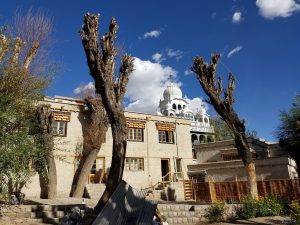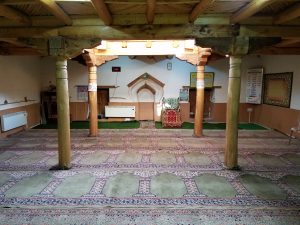One of my favorite places in Leh is the Central Asian Museum. About five steps off the main bazaar in the Tsas Soma (“Little Garden”) district of Old Town Leh, the museum is dedicated to Ladakhi history and trade. For centuries, Leh was a main stoppage point or caravanserai for merchants traveling between Lhasa, Kashmir, Yarkand, and India. While the city itself remained small–even now, the population stays at a very modest 30,000–its importance to Himalayan trade is reflected in Ladakh’s diversity of religions, histories, and people. The museum houses much of this in its three stories, each one dedicated to a particular cultural aesthetic. As conceptualized by the late architect Andre Alexander in conjunction with Ladakhi organization Anjuman Moin-ul Islam, the Central Asian Museum is a home not only to the things people brought with them to Leh, but the art, architecture, and culture that grew and flourished in this cosmopolitan center.
It also has one of the best views of Leh, and probably the best you can get without making the climb up to Leh Palace or Sankar Gompa, which overlook the whole city.
Tucked into a corner of the museum’s courtyard is a square, single-story building. Made of mud brick and locally-sourced timber, it doesn’t seem to be anything more than another part of the museum’s dedication to Ladakhi history. But the building is more than a simple part of a museum. It is the Masjid Sharif, the oldest mosque in Leh Town and one of the first major renovation projects on Muslim space in Leh.
According to the Tibetan Heritage Fund’s Leh Old Town Initiative (LOTI), Masjid Sharif or the Tsas Soma mosque was originally built during the 16th or 17th century. At the time, Leh’s king had married a Balti Muslim princess who had moved to the city with her court. Space was given to these craftspeople and courtiers in the Tsas Soma district, just beneath the palace. The Tsas Soma mosque provided a space for worship and prayer, and also highlighted a designated merchant district. While the Jama Masjid’s construction in 1666/7 would soon replace Masjid Sharif for weekly prayer and community gathering, the small old mosque remained in use through the 20th century before falling into disrepair in the 1960s or 1970s.
Following restoration efforts by LOTI and Anjuman Moin-ul Islam in 2005-2007, Masjid Sharif is today a site of Ladakhi heritage and history. But it is also a site of living Islam. It does not have the space for jummah like the Jama Masjid or Imamia Masjid next door, but Masjid Sharif may still play an important role for the community. Prayer rugs are laid out inside, and Muslims can be seen occasionally going in for namaz in small groups. What’s more, the mosque may have been intended for women’s worship. According to local historian Abdul Ghani Sheikh in his book Reflections on Ladakh, Tibet, and Central Asia (2010), the mosque had been used by women during the turn of the 20th century, providing a space for prayer and community outside of the home. Who uses the mosque, and how it fits into the Central Asian Museum as a whole, will be a very important topic to explore while I’m back in Leh.

